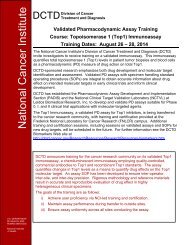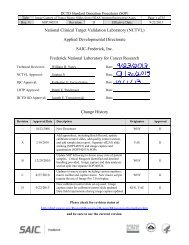National Cancer Institute - NCI Division of Cancer Treatment and ...
National Cancer Institute - NCI Division of Cancer Treatment and ...
National Cancer Institute - NCI Division of Cancer Treatment and ...
You also want an ePaper? Increase the reach of your titles
YUMPU automatically turns print PDFs into web optimized ePapers that Google loves.
Several BRB statisticians demonstrated<br />
that naïve application <strong>of</strong> st<strong>and</strong>ard statistical<br />
inference procedures to these measures<br />
<strong>of</strong> association can result in greatly<br />
inflated testing type I error rates <strong>and</strong><br />
confidence intervals with poor coverage<br />
probabilities. These results suggest that<br />
some <strong>of</strong> the claims <strong>of</strong> exceptional prognostic<br />
classifier performance that have<br />
been reported in prominent biomedical<br />
journals in the past few years should be<br />
interpreted with great caution.<br />
Lusa L, McShane LM, Radmacher MD, Shih JH,<br />
Wright GW, Simon R. Appropriateness <strong>of</strong> some<br />
resampling-based inference procedures for<br />
assessing performance <strong>of</strong> prognostic classifiers<br />
derived from microarray data. Revision under<br />
review with Stat Med.<br />
Drs. Zhao, Li, <strong>and</strong> Simon developed a mixture<br />
model-based normalization method<br />
that adaptively identifies non-differentially<br />
expressed genes <strong>and</strong> thereby substantially<br />
improves normalization for dual-labeled<br />
arrays in settings where the assumptions<br />
<strong>of</strong> global normalization are problematic.<br />
Zhao Y, Li MC, Simon R. An adaptive method for<br />
cDNA microarray normalization. BMC Bioinformatics<br />
2005:6;28.<br />
Clinical Trial Designs for the<br />
Development <strong>of</strong> Cytostatic Drugs<br />
Many new anticancer agents being developed<br />
are not cytotoxic <strong>and</strong>, therefore, may<br />
not cause tumors to shrink appreciably.<br />
However, these agents may still <strong>of</strong>fer<br />
significant clinical benefit to patients<br />
by delaying the progression <strong>of</strong> disease.<br />
Because st<strong>and</strong>ard phase I/II/III clinical trial<br />
development <strong>of</strong> agents depends on their<br />
ability to show activity in phase II trials<br />
by tumor shrinkage, new approaches are<br />
■ ■ ■<br />
Naïve application <strong>of</strong> st<strong>and</strong>ard statistical<br />
inference procedures can result in errors.<br />
needed. BRB statisticians Drs. Hunsberger,<br />
Korn, <strong>and</strong> Rubinstein discuss <strong>and</strong> evaluate<br />
several new design approaches.<br />
Korn EL, Rubinstein LV, Hunsberger SA, Pluda JM,<br />
Eisenhauer E, Arbuck SG. Clinical trial design for<br />
cytostatic agents <strong>and</strong> agents directed at novel<br />
molecular targets. In: Strategies for Discovery <strong>and</strong><br />
Clinical Testing <strong>of</strong> Novel Anticancer Agents. Adjei<br />
AA, Buolamwini J, eds. New York: Elsevier; 2005.<br />
Hunsberger S, Rubinstein LV, Dancey J, Korn EL<br />
Dose escalation trial designs based on a molecularly<br />
targeted endpoint. Stat Med 2005:24;<br />
2171–81.<br />
Drs. Freidlin <strong>and</strong> Simon evaluated two<br />
kinds <strong>of</strong> r<strong>and</strong>omized designs for the early<br />
development <strong>of</strong> target-based cytostatic<br />
agents: r<strong>and</strong>omized discontinuation <strong>and</strong><br />
upfront r<strong>and</strong>omization designs. They<br />
showed that the r<strong>and</strong>omized discon-<br />
tinuation design is not as efficient as<br />
upfront r<strong>and</strong>omization if treatment<br />
has a fixed effect on tumor growth<br />
rate or if treatment benefit is<br />
restricted to slower-growing<br />
tumors. The r<strong>and</strong>omized<br />
discontinuation design<br />
can be advantageous if only<br />
a subset <strong>of</strong> patients, those<br />
expressing the molecular<br />
B I O M E T R I C R E S E A R C H B R A N C H ■ 21










